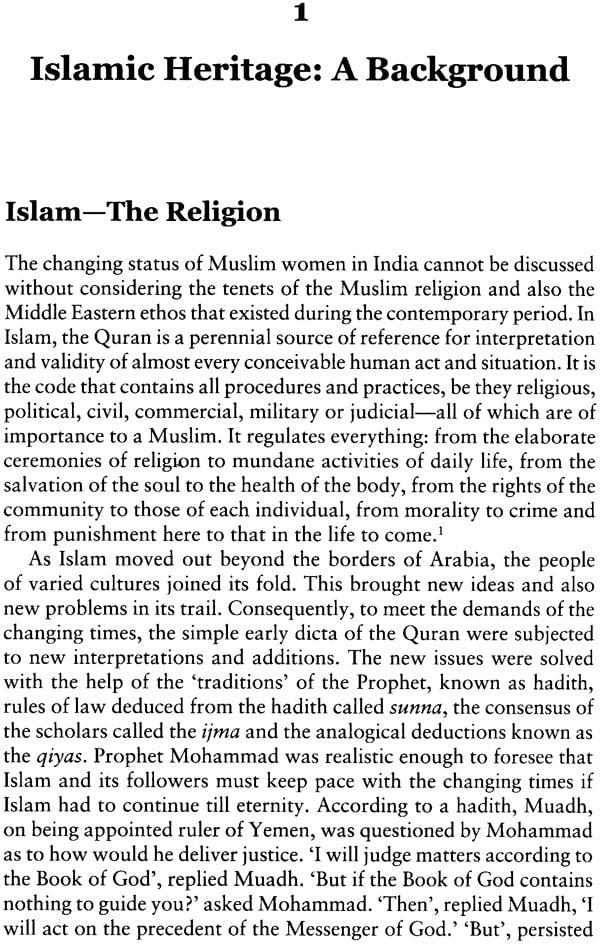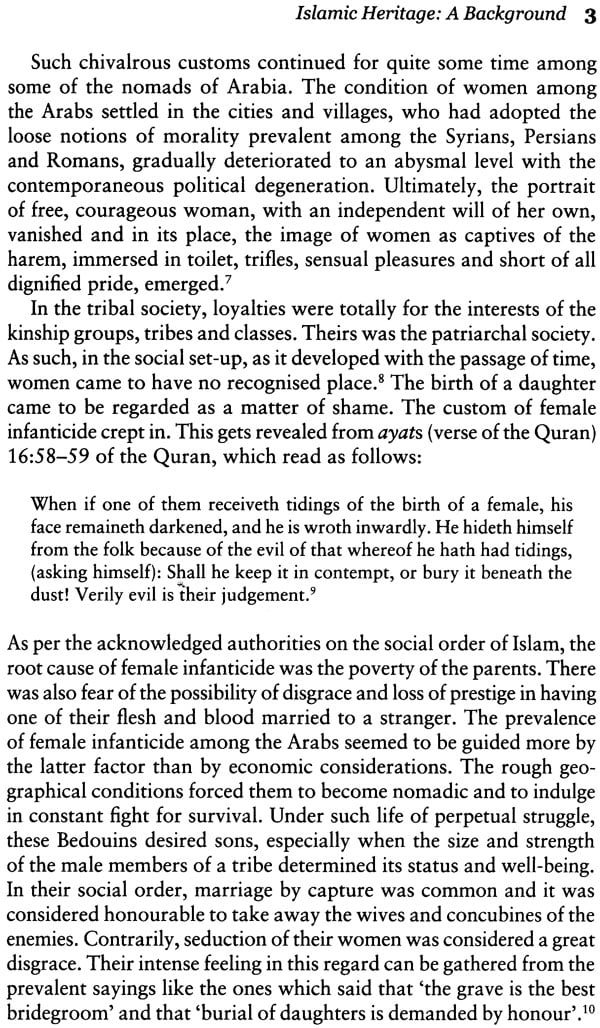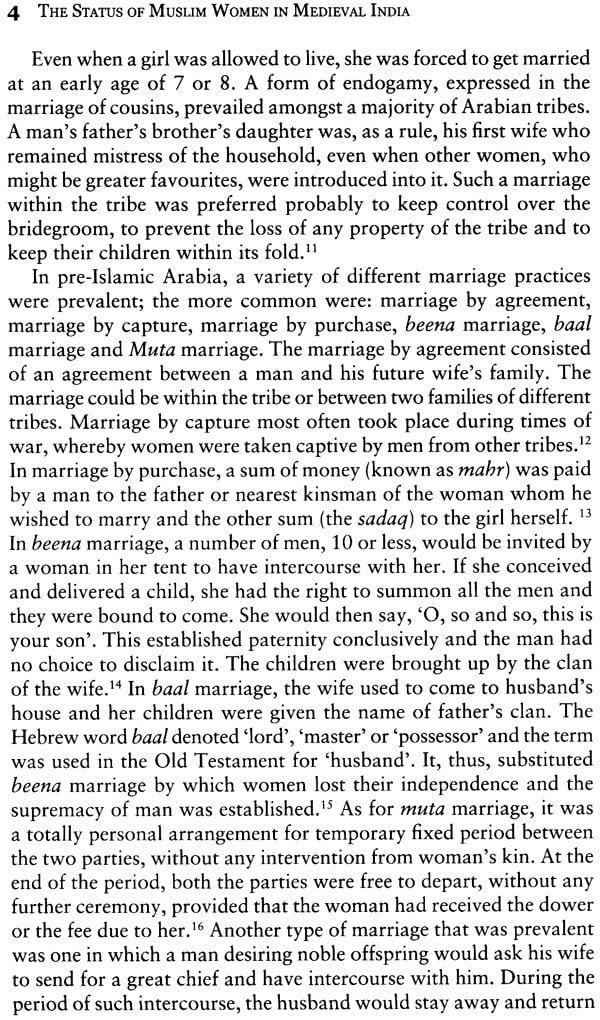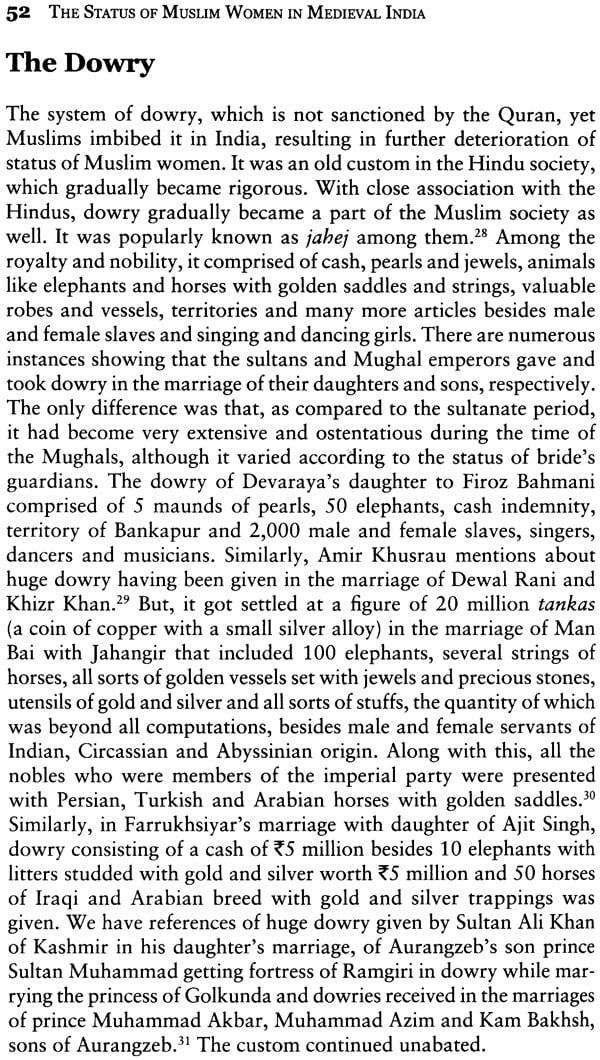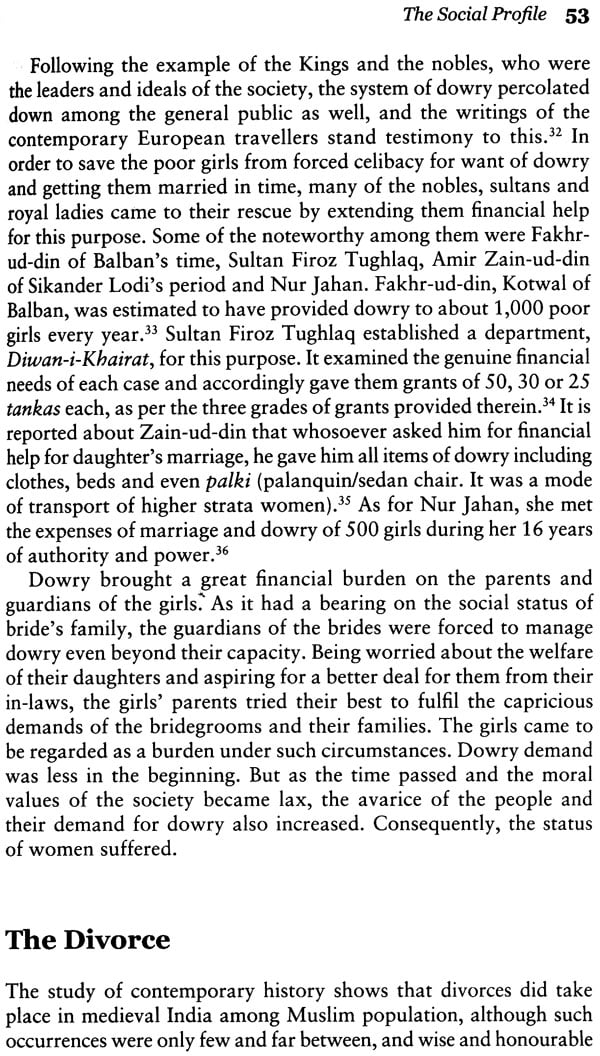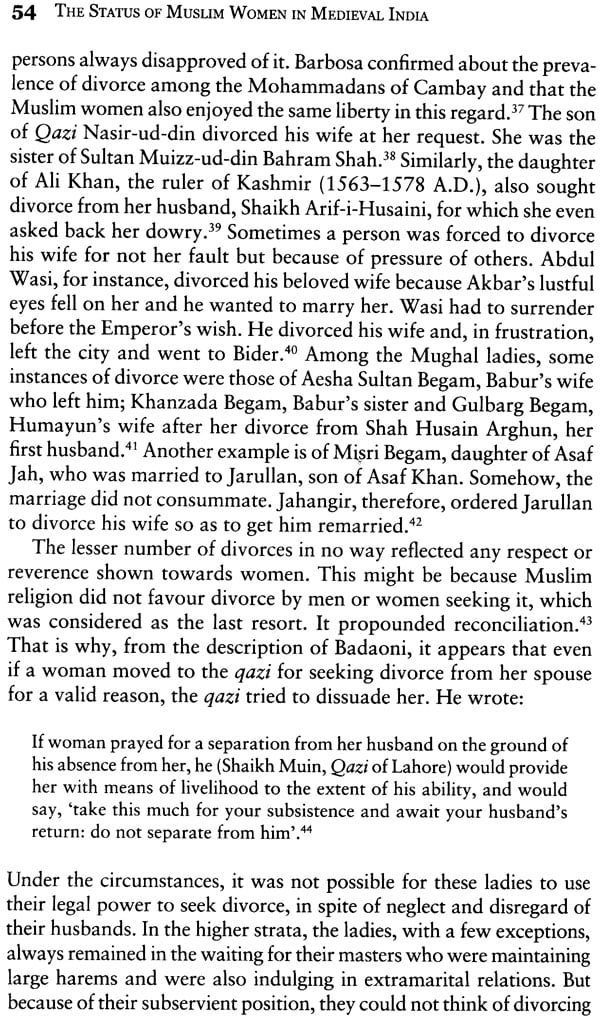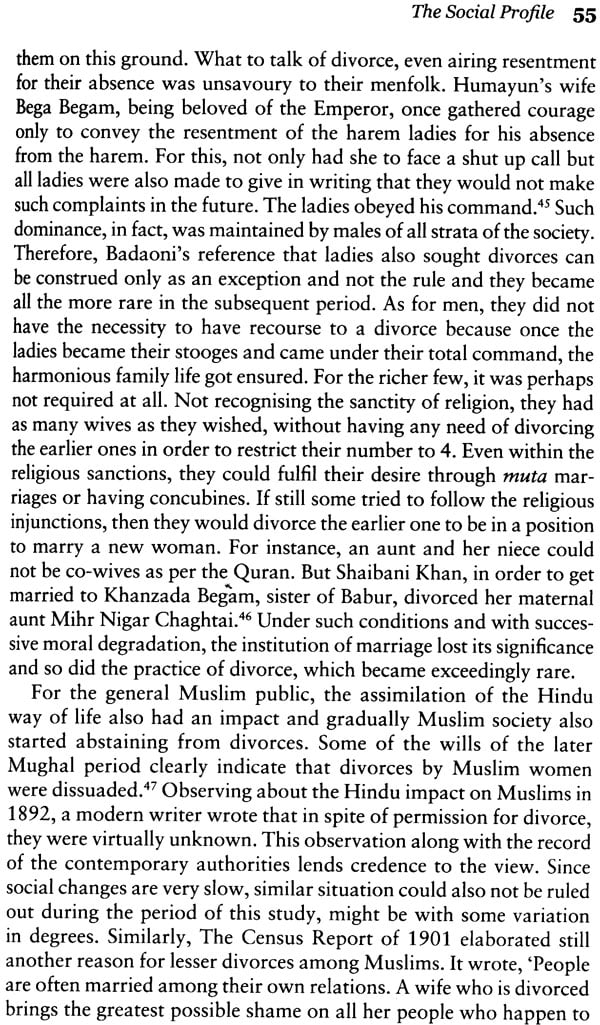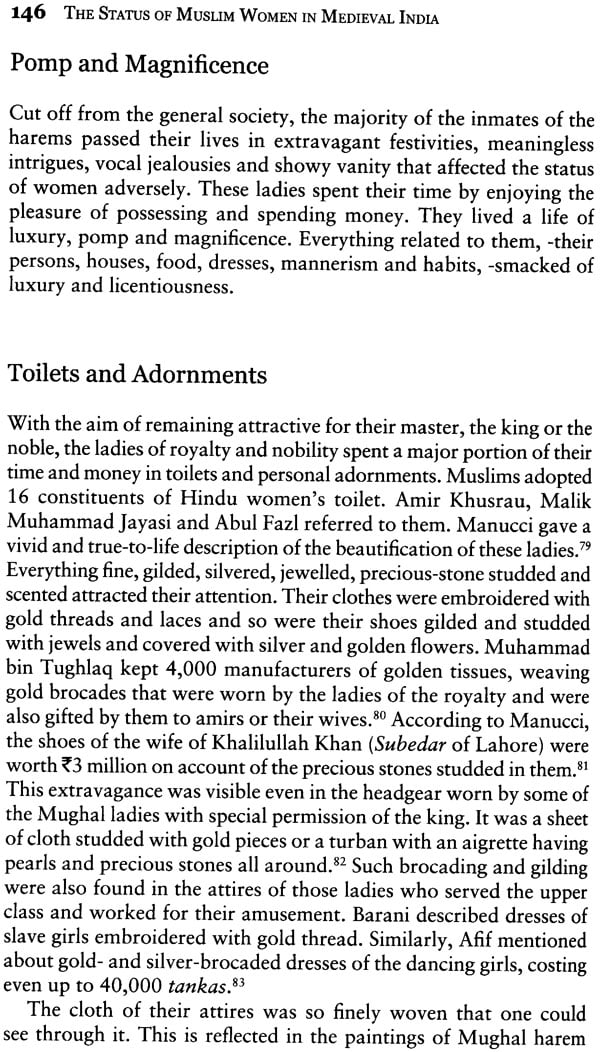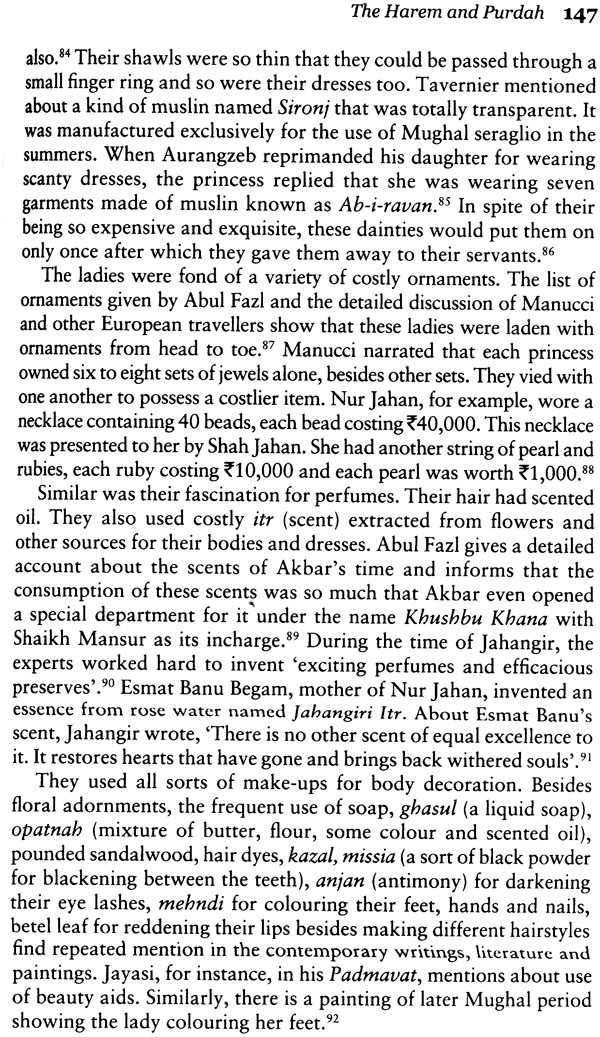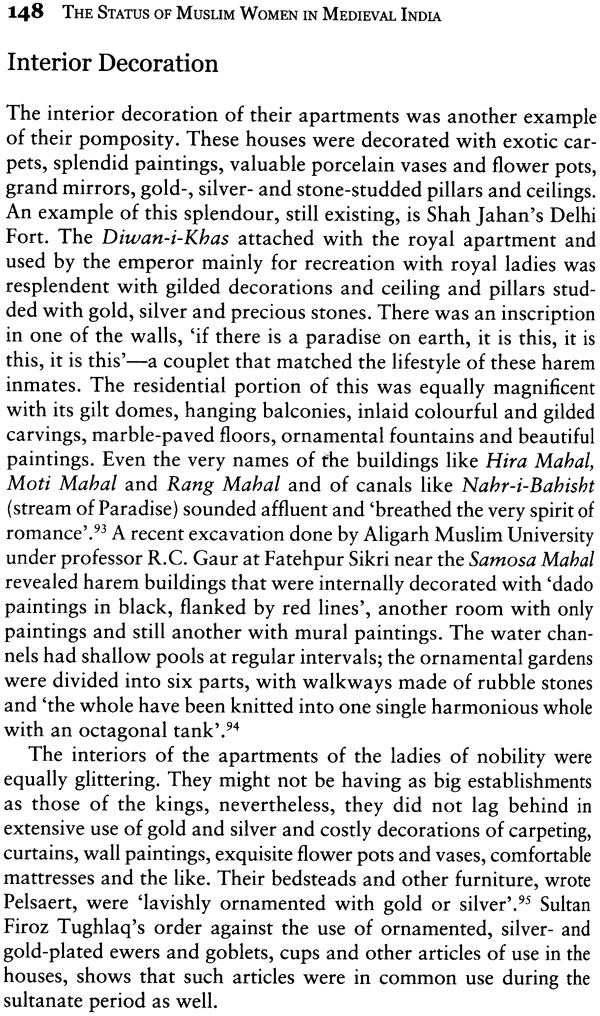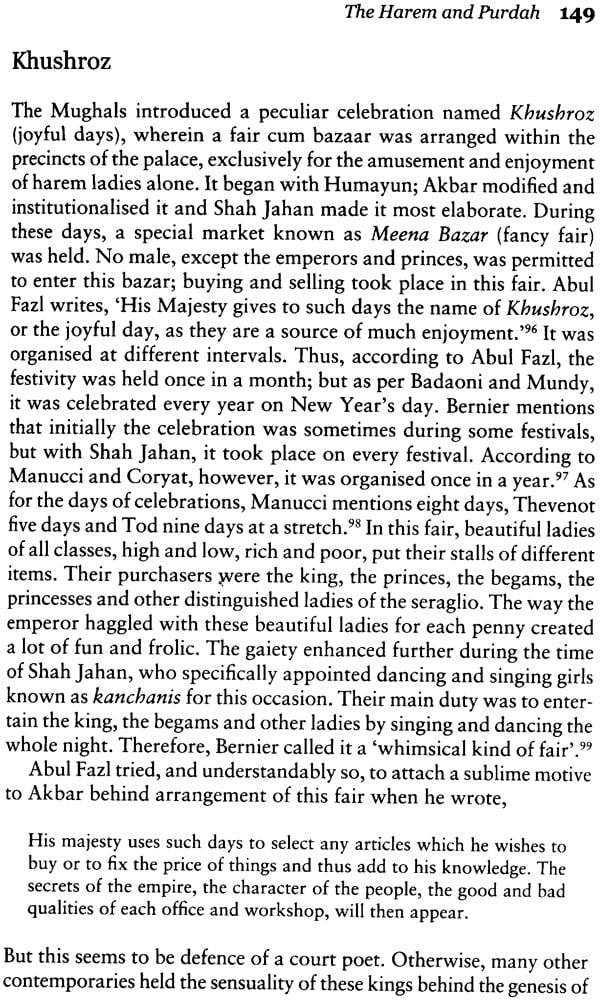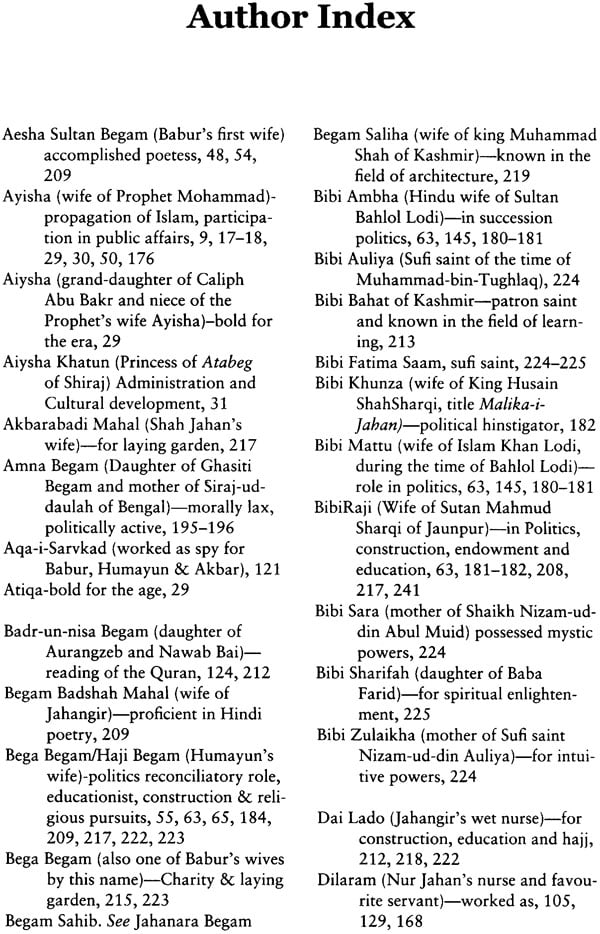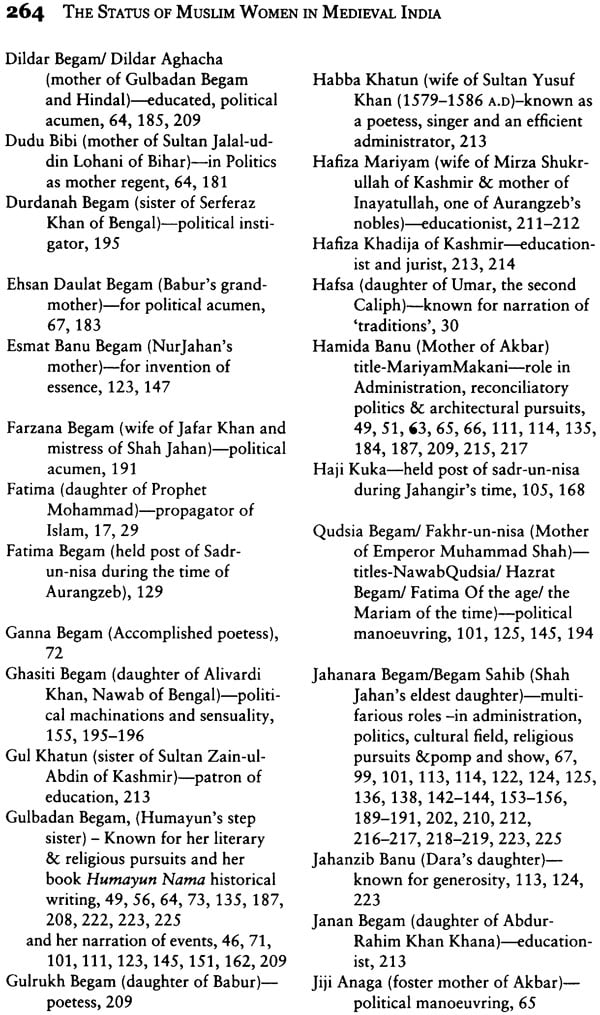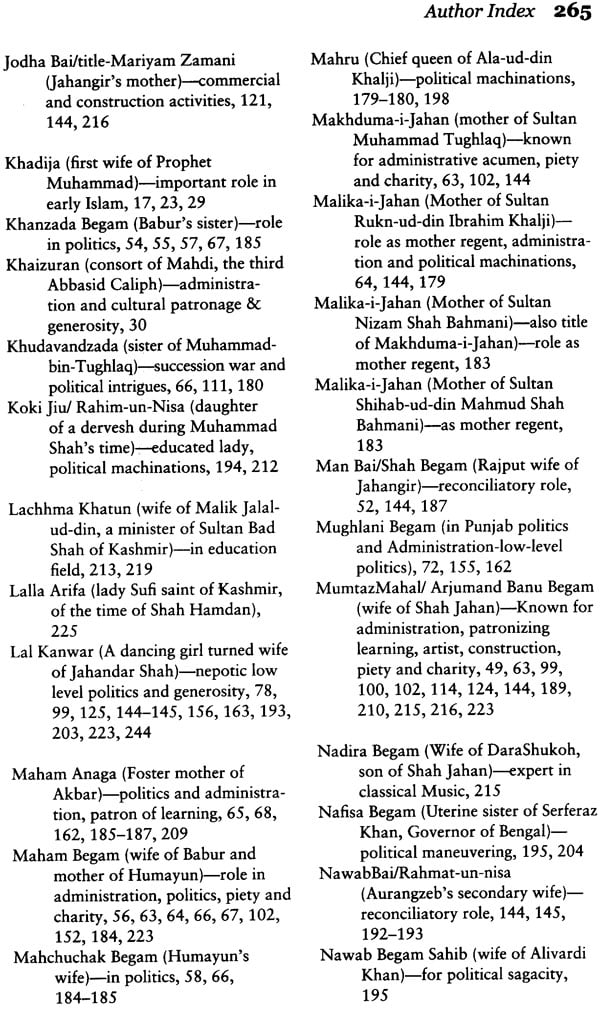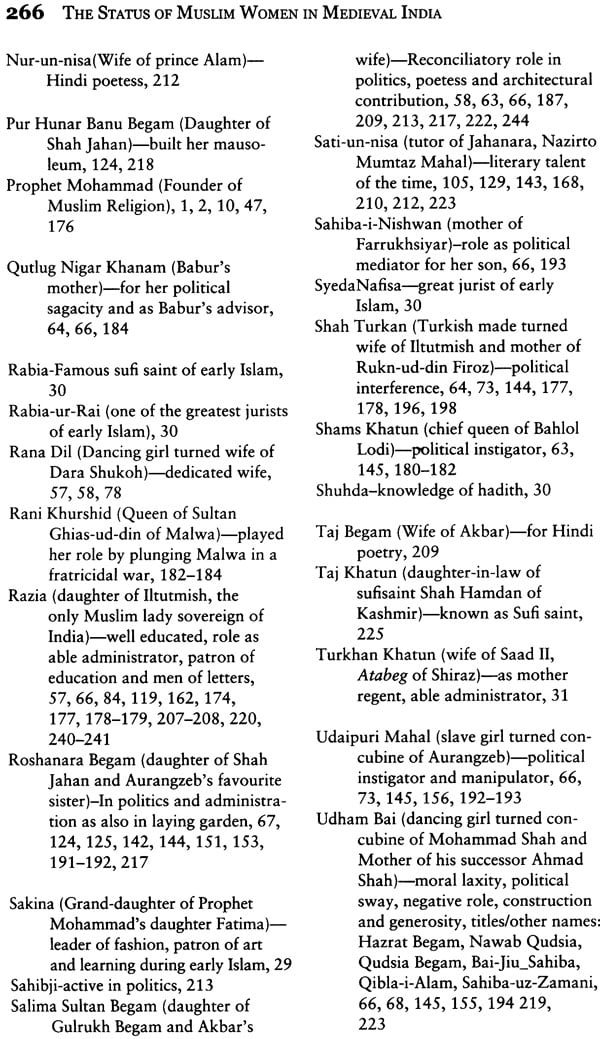
The Status of Muslim Women in Medieval India
Book Specification
| Item Code: | NAM267 |
| Author: | Sudha Sharma |
| Publisher: | Sage Publications India Pvt. Ltd. |
| Language: | English |
| Edition: | 2016 |
| ISBN: | 9789351505662 |
| Pages: | 281 |
| Cover: | Hardcover |
| Other Details | 9.0 inch X 6.0 inch |
| Weight | 450 gm |
Book Description
This book examines the economic, cultural, political and social positions of Muslim women in medieval India. It explores the changes that took place with the advent of Arabs, Turks, Mongols, Tartars, Afghans and Persians whose customs and traditions influenced the existing Islamic society.
Though Islam improved the position of women by instituting many reforms, the Islamic religious texts laid down the minutest code of conduct for women, the slightest deviation from which was considered irreligious. Such rigidity, coupled with the apathy of the ulemas, led to the weakening of the position of women
The book goes on to show how the diktats of the Quran were subjected to many interpretations down the ages, affecting the status of women in various ways.
Sudha Sharma is on the Board of Directors, Indraprastha Gas Limited, New Delhi. She was the former Chairperson of Central Board of Direct Taxes (CBDT), New Delhi. She has served as Director General (Vigilance) of the Income Tax (IT) department in the national capital before her appointment to the top body.
Dr Sharma has 37 years of experience in the fields of administration, different tax matters such as, assessment, appeals, printing, publishing and advertisement, promotion of official language, computerisation, investigation, international negotiations and signing treaties (Double Taxation Avoidance Agreement [DTAA] and Tax Information Exchange Agreement [TIEA]) and vigilance, both in the government and the public sector.
Dr Sharma did her PhD in History from Punjab University and started her career as a lecturer of History in Hans Raj Mahila Mahavidyalaya, Jalandhar.
Woman has been considered, through ages, as the prime mover of family and the society alike. The term 'status' refers to the position of woman as a person in the social structure, defined by her designated rights and obligations. Each 'status-position' is explained in terms of a pattern of behaviour expected of the incumbent. The role and status assigned to women in the society have always been a yardstick to assess the level of progress of civilisations. The book traces the status of Muslim women in medieval India in terms of their social, economic, political and cultural roles.
At its inception, the book traces the status of women in pre- Islamic Arabic tribal society during its dark age where women had no recognised place except that they were considered a mere property. Islam improved their position and instituted many reforms, effecting a marked improvement in their status. However, the Islamic religious text, like in other spheres, laid down the minutest code of conduct for women, the slightest deviation from which was considered irreligious. Such rigidity, coupled with the apathy of the ulemas (Muslim religious scholars/the Muslim theologians, who were considered competent to interpret the holy Quran and Sunnah (traditions of Prophet Mohammad)1 for any change, made the fort of Islam almost impregnable, resulting in the static status for Muslim women within the Islamic fold. The subsequent historical developments, however, brought different clans within its fold, comprising mainly Arabs, Turks, Mongols, Tartars, Afghans and Persians. Each group had its own clannish traits and norms concerning women. As a result, assimilation of different ethnic groups influenced the Islamic society, even though they retained some of their own customs and traditions. Such group interactions were different in different countries; hence, there also appeared regional diversity within the Islamic fold. Accordingly, the early dicta were now understood in the light of the new experience and, thus, the Quran was subjected to many interpretations, including about the status of women.
Islam came to India loaded with influences of other ideologies and underwent further changes after intermixing with the Hindu way of life at that point of time. Most of the Muslim invaders, who came to India, were not accompanied by women, and hence they took local women for wives. Thus, the forcible conversions by the attackers or the intrusion through marriages with Indian women, combined with intermingling with the local culture and the varying policies of different kings at different points of time, brought about a change in the status of Muslim women' from time to time. Women in India in the contemporary period had fallen very low from the exalted position they once enjoyed. It did not take many years for Muslims to adopt new ways for their own women as well.
The literature on women during medieval period is scanty and, therefore, studies on Muslim women are only a few. Some authors deal with individual aspects and problems of Muslim women in contemporary India. However, the study of their status in medieval India had, more or less, remained peripheral in the contemporary chronicles and the modern works. Since Muslim women remained in seclusion, public reference to them was avoided unless someone played a significant role in politics, literature or any other field. We find references in the memoirs of the contemporary Indian kings, diaries and dispatches of Christian missionaries, travel accounts of foreign travellers, contemporary Hindi and Persian writers and Edicts from the harem that throw light on the attitude of that society towards Muslim women. However, whatever references are found, these have to be interpreted and analysed in the light of the background and limitations of the contemporary chroniclers. Modern works primarily focus on the role of women connected with royalty and nobility of that time.
This book is an attempt to analyse the changing socio-economic- politico-cultural status of Muslim women of all classes in medieval India (13th-18th century). It is divided into six chapters, followed by a conclusion and a bibliography.
Each chapter is followed by 'references' in the endnotes that are related with the aspects discussed within the chapter.
Chapter 1 gives the background. It dwells on the status of women in the pre-Islamic Arabic society and then further discusses the tenets of Islam as to how and to what extent did it improve the status of women. The chapter further traces the spread of Islam, different clans joining Islam and the status of women within these respective clans, which ultimately led to new interpretations about position of women within the Islamic fold.
Chapter 2 deals with the social profile of Muslim women during the period of this study. It discusses at length as to how the degenerating status of women in the contemporary Indian society was also adopted by the Muslims and how, ultimately, Muslim women, in general, became totally subservient to their menfolk and, except an exception here and there, became victim of social apathy and neglect. Due light has also been thrown on the position of special classes of ladies like dancing girls, prostitutes, widows, female relations, slave girls, besides morality of women and general social attitude towards them.
Chapter 3 discusses the economic rights and privileges of the Muslim ladies of different economic standing-royalty, nobility and common classes. It narrates how the royal and high-strata ladies were very well provided for through different means, varying according to their status within the harem, their importance in the political set-up and the financial resources of their masters. The chapter also narrates the concern of the royalty for female subjects of all classes and they all were given sufficient grants, in different forms, for their maintenance Their mahr (obligatory bridal money/possession paid! promised for marriage contract), ownership and inheritance rights have been discussed. The economic activities of different sections of unprivileged classes have also been elaborated in this section.
Chapter 4 dwells on harem and purdah. It narrates how a large harem had become a status symbol and how Mughals added to the number of harem inmates by following the policy of seeking peace and strengthening relations through matrimonial alliance. The Muslim jealousy about their wives was proverbial. A detailed narration has been made as to how they guarded them, provided for their dwellings and expenses and worked out, during the time of Mughals, an elaborate system of internal management for the security and maintenance of the harem inmates. The chapter gives a detailed account of activities of the ladies of royalty and nobility in harems and also their life of splendour, pomp and luxury, which, in fact, impacted their status negatively. The practice of purdah, which had become common and came to be regarded as symbol of honour, has also been discussed in this section. It has been made clear with examples as to how different stress was laid on observance of purdah during different periods in history. The role of purdah in the lower strata of the society has been reviewed distinctly. It is interesting to observe how the rigidity with which purdah was adopted reduced the status of Muslim women and had varying adverse impact on ladies of different classes.
Chapter 5 discusses the role of Muslim women on political platform. In this respect, important role played by different ladies of royalty, nobility and high birth or even concubines and dancing girls at different points of time-as active participators or regents of the minor kings or as manipulators behind the scene-has been discussed. The influence of these ladies varied from time to time according to their personality, family connection, political situation and the character of the sultan or the emperor. The chapter contains a detailed description of such participation by different ladies, which depicts how with the weakening of the empire and the royalty falling into debauchery, the ladies of low birth like dancing girls and concubines gained greater sway in court machinations in the later period in contrast to the positive role played by royal ladies like Razia or Nur Jahan in the earlier period.
Chapter 6 focuses on cultural achievements and pursuits of Muslim women during the period under study. In this domain, the common Muslim women had little to contribute because of their educational backwardness and prevalence of early marriage and purdah. The narration brings out that as the kings of the sultanate period were conservative, their ladies did not make a mark, except a few like Razia, who patronised education. However, Mughals made arrangements for education of harem ladies. Instances have been explored wherein Mughal ladies made a mark in different fields like education, writing, fine arts, designing, laying beautiful gardens, architecture, etc. Their acts of charity and religious piety have also been highlighted, which did enhance the social status of the Muslim women.
The last chapter gives, in conclusion, an overview of the status of Muslim women as it changed during the course of history in medieval India. It is further followed by a list of references titled 'Bibliography'.
The literature in this book largely emanates from my Doctoral thesis with the title 'Changing Status of Muslim Women in Medieval India Till 1761', which was accomplished under the guidance of renowned scholar of history, late Dr R.C. Jauhri, then Professor of History, Panjab University, Chandigarh. Additional material and latest references have been induced to make the reading more contemporary. Thus, this book holds authentic reference for those studying the position of Muslim women from all aspects in medieval India.
A pointed research, an analysis and interpretation of the literature of medieval India could not be accomplished without reference to the archival works, most of which are available in Persian. It warrants assistance from authorities in Islamic Studies, besides experts in Persian language, to read and assimilate. Many learned scholars, especially Dr Madhukar Arya of Persian Department of Panjab University, Chandigarh, and Dr Mohammad Afzal Khan of History Department of Aligarh Muslim University, rendered valuable assistance in my endeavour to understand the subject in its right perspective. I extend my gratitude to all of them.
I am grateful to the authorities of Aligarh Muslim University; National Archives, New Delhi; Indian Institute of Islamic Studies, Tughlaqabad; Khuda Bakhsh Oriental Public Library, Patna; U.P. Archaeological Department, Lucknow; Panjab University, Chandigarh; Central Library, Chandigarh; Dwarka Dass Library, Chandigarh; Vishveshwara Nand Library, Hoshiarpur; Government College, Hoshiarpur; Lajpat Library, D.A.V. College, Jalandhar; Doaba College, Jalandhar; Lyallpur Khalsa College, Jalandhar and host of other institutions for permitting me to use their libraries for collecting the research material. I thank Dr K.L. Sachdeva, former Lecturer at D.A.V. College, Jalandhar, for allowing me an access to his rich personal library. My husband, S.M. Sharma, provided me with much-needed moral support. I am also thankful to my children, Himani, Garima and Kinshuk, who smiled away the deprivation of motherly care during this research and also provided technical support.
My profuse appreciation and thanks are due to SAGE Publications for bringing this book to the readers in a lucid and presentable form.
| Preface | vii | |
| 1 | Islamic Heritage: A Background | 1 |
| 2 | The Social Profile | 44 |
| 3 | Economic Milieu | 98 |
| 4 | The Harem and Purdah | 137 |
| 5 | Political Platform | 176 |
| 6 | Cultural Context | 205 |
| Conclusion | 236 | |
| Bibliography | 243 | |
| Author Index | 263 | |
| Subject Index | 268 | |
| About the Author | 270 |
